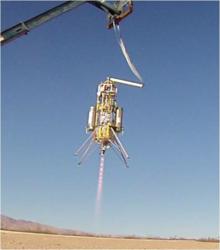
Cambridge, MA (PRWEB) January 23, 2012
NASA could test its payloads on Earth under realistic flight conditions before sending them into space by using a technology flown by Draper Laboratory last month.
Using the GENIE (Guidance Embedded Navigator Integration Environment) System, Draper recently fully controlled the Xombie suborbital rocket built by Masten Space Systems during a closed loop tethered flight at the Mojave Air and Space Port in California. This successful first step brings the NASA Dryden Flight Opportunities Program closer to a new testbed capability that could be used to validate future planetary technology payloads.
Aircraft available to test NASA instruments today are unable to fly at the desired trajectories for planetary landings, and computer simulations are used to generate that data. However, a GENIE controlled flight vehicle could mimic a spacecraft?s final approach to the Moon and Mars here on Earth. Emerging and advancing future space technologies will then have the opportunity to fly their payloads terrestrially to raise their overall Technology Readiness Level and show that they are ready for use in space.
A video of the demonstration can be found on YouTube at: http://goo.gl/EhnDJ.
Draper plans to conduct a free-flying demonstration with GENIE and the Masten rocket later this winter.����
The GENIE precision landing GN&C system was developed jointly between Draper and the NASA Johnson Space Center (JSC) under the Autonomous Landing Hazard Avoidance Technology (ALHAT) and Morpheus lander programs.
Draper Laboratory
Draper Laboratory is a not-for-profit, engineering research and development organization dedicated to solving critical national problems in national security, space systems, biomedical systems, and energy. Core capabilities include guidance, navigation and control; miniature low power systems; highly reliable complex systems; information and decision systems; autonomous systems; biomedical and chemical systems; and secure networks and communications.
http://www.draper.com
No comments:
Post a Comment